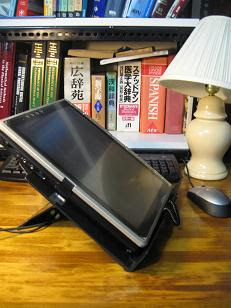[Tech tips] Fixing an overheating Toshiba Portegé M200 tablet PC (2)
This is an additional note to a previous post. It is a tip on how to orient the tablet when using it upright (i.e. using it as a tablet on a book stand as depicted below, or held in your lap).
I have found out that the Portegé M200 tablet runs much cooler (and quieter) when the left side (nearest to tab key) or the back side (nearest to function keys) faces up (towards the ceiling) than if the right/bottom side faces up.
GOOD ORIENTATIONS... back side up / left side up
BAD ORIENTATIONS... front side up / right side up
The reason is easy to understand given the design of the cooling system (see pictures). Hot coolant rises up, so coolant circulates much better if the radiator is physically higher than the CPU. If you do the opposite, the heat will tend to rise towards the CPU, away from the radiator, and cooling will be less efficient.
Even if you use the tablet flat on a desk, tilting it slightly in the above orientations, with a book or something, should help to cool it too (I haven't tested this).






